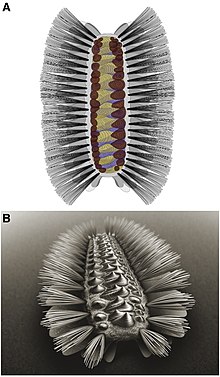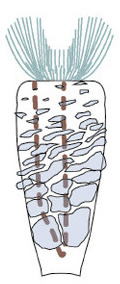| Tommotiids Temporal range:
| |
|---|---|

| |
| Intepretive drawing (top) and life restoration (bottom) of Wufengella a camenellan, and one of the few tommotiids known from articulated remains | |

| |
| Life restoration of Eccentrotheca, a sessile tommotiid | |
| Scientific classification | |
| Domain: | Eukaryota |
| Kingdom: | Animalia |
| Clade: | Lophophorata |
| Stem group: | †"Tommotiida" |

Tommotiids are an extinct group of Cambrian invertebrates thought to be early lophophorates (the group containing Bryozoa, Brachiopoda, and Phoronida).[3][4][5]
The majority of tommotiids are mineralised with calcium phosphate rather than calcium carbonate,[6] although silicified examples hint that some species bore carbonate or carbonaceous sclerites.[7]
Micrina and Paterimitra possess bivalved shells in their larval phases, which preserve characters that might position them in the Linguliformea and Rhynchonelliformea stem lineages respectively. This would indicate that the brachiopod shell represents the retention of a larval character.[8]
For a long part of their history, the tommotiids were only known from disarticulated shells - a complete organism had not been found. The 2008 discovery of Eccentrotheca offered the first insight into a complete organism, and permitted a reconstruction of the animal as a sessile, tube-like animal made up of a spiral of overlapping plates.[5][7] Articulated specimens of Paterimitra, discovered a year later, suggest a similar form and lifestyle - it is possible that many tommotiids need redescribing as sessile tube-dwellers.[9] Eccentrotheca and other similar sessile tommotiids were likely filter feeders, similar to modern lophophorates.[10]
However, the discovery of the articulated camenellan Wufengella showed that it was a free-living worm-like animal, suggesting that it was not a crown-group lophophorate, as the last living common ancestor of all living lophophorates has been predicted to be sessile, as bryozoans, brachiopods and phoronids are. This indicates that tommotiids are paraphyletic, with some tommotiids more closely related to bryozoans, brachiopods and phoronids than to other tommotiids.[10]
These discoveries have produced an alternative model for the origin of the brachiopods; it suggested that they evolved by the reduction of sessile tube-like organisms, until only two shells were left. This contrasts with the brachiopod fold hypothesis which suggests that they formed by the folding of a halkieriid-like organism.[5]
- ^ Cite error: The named reference
Skovsted2011was invoked but never defined (see the help page). - ^ Skovsted, Christian; Bassett-Butt, Lewis (2015). "Discovery of the youngest known tommotiid from the middle Cambrian (Drumian) Nelson Limestone of Antarctica". Diva.
- ^ Holmer LE, Skovsted CB, Brock GA, Valentine JL, Paterson JR (June 2008). "The Early Cambrian tommotiid Micrina, a sessile bivalved stem group brachiopod". Biology Letters. 4 (6): 724–728. doi:10.1098/rsbl.2008.0277. PMC 2614141. PMID 18577500.
- ^ Taylor, Christopher (2008-06-27). "Back to the Scleritome - Tommotiids Revealed!". Catalogue of Organisms. Retrieved 2008-07-23.
- ^ a b c Skovsted CB, Brock GA, Paterson JR, Holmer LE, Budd GE (February 2008). "The scleritome of Eccentrotheca from the Lower Cambrian of South Australia: Lophophorate affinities and implications for tommotiid phylogeny". Geology. 36 (2): 171–174. Bibcode:2008Geo....36..171S. doi:10.1130/G24385A.1.
- ^ Bengtson, S. (2004). "Early skeletal fossils". In Lipps, J.H.; Waggoner, B.M. (eds.). Neoproterozoic-Cambrian Biological Revolutions (PDF). The Paleontological Society Papers. Vol. 10. pp. 67–78. doi:10.1017/S1089332600002345. Archived from the original (PDF) on 2008-10-03. Retrieved 2008-07-18.
- ^ a b Skovsted CB (2016). "A silicified tommotiid from the lower Cambrian of Greenland" (PDF). Bulletin of Geosciences. 91 (3): 553–559. doi:10.3140/bull.geosci.1609. ISSN 1214-1119.
- ^ Holmer LE, Skovsted CB, Larsson C, Brock GA, Zhang Z (2011). "First record of a bivalved larval shell in Early Cambrian tommotiids and its phylogenetic significance". Palaeontology. 54 (2): 235–239. doi:10.1111/j.1475-4983.2010.01030.x.
- ^ Skovsted CB, Holmer LE, Larsson CM, Högström AE, Brock GA, Topper TP, Balthasar U, Stolk SP, Paterson JR (May 2009). "The scleritome of Paterimitra: an Early Cambrian stem group brachiopod from South Australia". Proceedings of the Royal Society B: Biological Sciences. 276 (1662): 1651–1656. doi:10.1098/rspb.2008.1655. ISSN 0962-8452. PMC 2660981. PMID 19203919.
- ^ a b Guo, Jin; Parry, Luke A.; Vinther, Jakob; Edgecombe, Gregory D.; Wei, Fan; Zhao, Jun; Zhao, Yang; Béthoux, Olivier; Lei, Xiangtong; Chen, Ailin; Hou, Xianguang; Chen, Taimin; Cong, Peiyun (September 2022). "A Cambrian tommotiid preserving soft tissues reveals the metameric ancestry of lophophorates". Current Biology. 32 (21): 4769–4778.e2. doi:10.1016/j.cub.2022.09.011. S2CID 252564106.